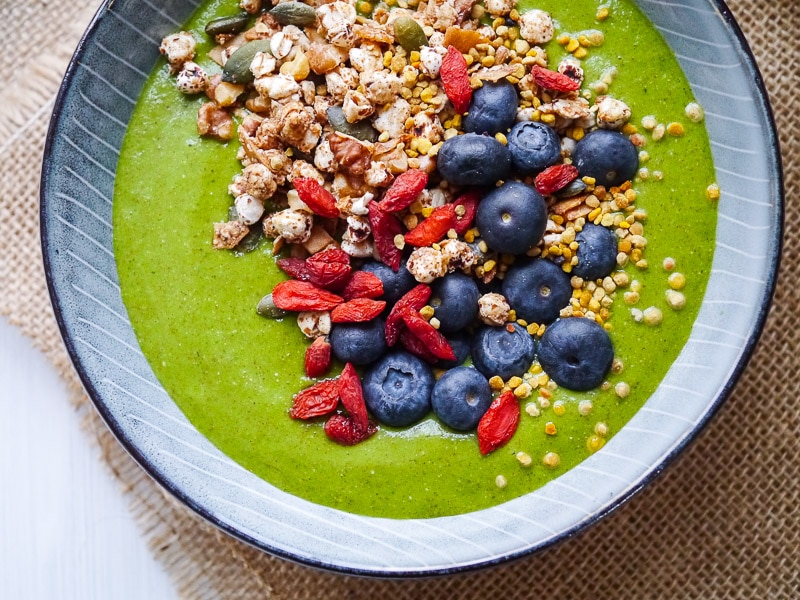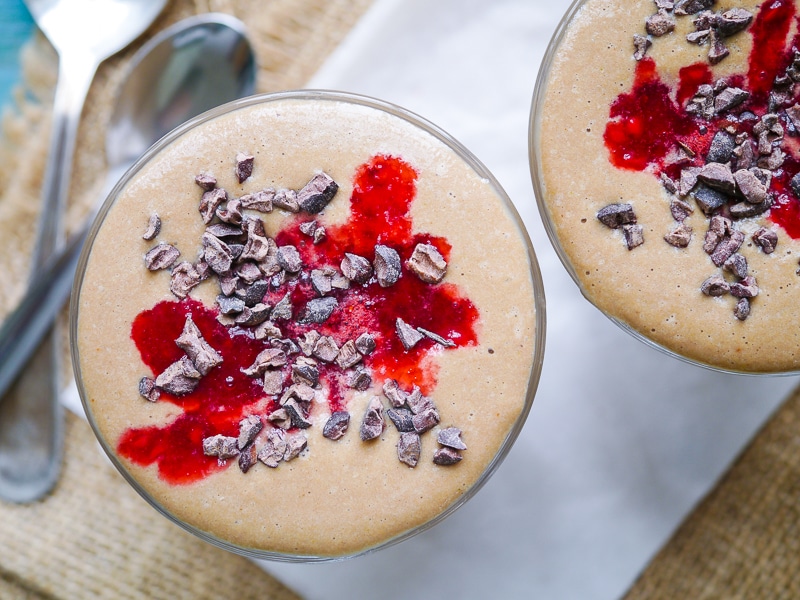How to make a balanced healthy smoothie
If you’re a busy person (especially in the mornings!) like me, whizzing together a big smoothie is an easy way to make a super speedy meal and get on with your day. Smoothies are also damn trendy these days, it seems…that can be a good and a bad thing!
Though the flavour combinations for a smoothie are pretty much endless, there are a few little points I typically follow when making up a healthy smoothie for myself to ensure I’m getting something that tastes good, but also contains a good balance of nutrients.
Choose a tasty base
My favourite base for a smoothie is a coconut-rice milk blend. This blend of milk is naturally quite sweet tasting and just a little creamy. But you can also use (i) regular cow’s milk (or goats milk), (ii) another non-dairy milk like almond, cashew or oat milk, (iii) coconut water or (iv) try using 1/2 – 1 cup of natural yoghurt or kefir (a fermented milk drink) and thinning out with water, as required. (This is a really easy way of adding additional protein and probiotics to your smoothie!)
When choosing a base, if you are using a non-dairy milk or a yoghurt, make sure to check the ingredients label. Ideally choose a base that does not contain any added sugar or lots of chemical ingredients you do not recognise.
(UK readers, I currently like to use Provamel Coconut Rice Drink or Rude Health Coconut Milk. Aussie readers, my home favourite is Cocoquench by Pureharvest)
Blend together a balance of macronutrients
Try and get your smoothie to cover protein, fat and carbohydrate needs. Striking a balance between the essential macronutrients means you’re likely to feel satisfied and replenished for longer.
- Use vegetables and fruit to create the bulk of your smoothie for something that’s not too sweet. Typically, we’d probably not sit down to three pieces of fruit if we were having a plated meal. So, rather than chuck the whole fruit bowl in the blender, mix up fruit and vegetables. This doesn’t just mean a handful of spinach…
- Other veggies that work well in a smoothie are (i) zucchini, (ii) cucumber, (iii) cooked and cooled beetroot or pumpkin (iv) other mild-tasting leafy greens like romaine or cos lettuce, kale, and chard.
- For thicker greens like kale and chard, lightly steaming and cooling the leaves will produce a smoothie that’s gentler on the stomach. If you have sensitive digestion I’d recommend using softer leaves like lettuce, or otherwise always cooking the thick ones.
- Make the most of your freezer! Chop up/cook your fruit and veggies in advance, pop them in zip lock bags and freeze. Not only will your smoothies be ready faster, they’ll be thicker and more luscious if you use one or two frozen items.
- Add nourishing, satiating healthy fats by incorporating nuts, seeds or nut butters. Adding a reasonable dose of fat to your smoothie not only helps you feel more satisfied, it adds flavour and an awesome creaminess!
- The easiest way to add fats is to pop in a couple teaspoons of your favourite nut and/or seed butter. This could be cashew butter, peanut butter or coconut oil/coconut butter. If you have a powerful blender, whole nuts/seeds are also an option.
- Another source of fats are your oil-rich seeds like (hulled) hemp seeds and chia seeds (use a few teaspoons of these per smoothie serving).
- If they’re in season, a quarter to half of an avocado makes a smoothie creamy and adds some of the best nutritious fats ever.
- Full-fat dairy products also contain fats so another option is to use a dairy product as your smoothie base. This can be milk and/or yoghurt.
- Keep yourself full by adding protein; this can be protein powder or other forms. Protein is needed to fuel the natural cell replenishment cycle our bodies are continuously undertaking. A scoop of quality protein powder obviously makes the protein part mega simple. I know protein powders get a really bad rap and it’s true many of them are loaded with artificial ingredients. But there are plain, natural options out there.
- Look for a neutral or minimally-flavoured powder which only lists ingredients you can recognise. Plant-based options include pea, brown rice and/or hemp protein, or you can use a whey protein if you are comfortable eating animal products.
- If you don’t want to use protein powder, use protein-rich seeds like chia or hemp (add a heaped tablespoon), and/or throw in a few spoonfuls of protein-rich cereal flakes like buckwheat or quinoa flakes.
- Another option is to use natural yoghurt as your base, as I suggested above. 1 cup of natural yoghurt contains approximately 9-15 grams of protein, depending on the brand.
- Don’t forget to add some carbs; these can come from fruit, vegetables and/or grains. Carbohydrates are our basic fuel! Our central nervous system, especially our brain, relies on glucose for energy, and glucose is most easily metabolised from carbohydrate. They’re the easiest part of the smoothie to work in as most of the bulky ingredients will give you some carbs. But just to recap it for you, sources of quality carbohydrates you can include in a smoothie are:
- fruits (banana and berries are really easy),
- root vegetables (i.e. pumpkin or beetroot), and
- cereal flakes like rolled oats or flaked buckwheat, rice or quinoa. Each of these ingredients also adds thickness and creaminess to your smoothie, which is definitely not a bad thing!
Slow down and enjoy eating
Though smoothies do make excellent meals on the go, I try not to slurp mine down too quickly. More often than not, I top my smoothie with something crunchy – homemade granola, chopped nuts, seeds, berries, etc. – to slow down my eating and allow myself to actually chew something, which helps stimulate digestion.
I know they’re not for everyone, but I am a “smoothie bowl” fan (i.e. I make my smoothie thick, pour it into a bowl and top it with things). When I am able to, sitting down to my smoothie as a meal in a bowl – and don’t worry, I make big smoothies! – is something I just love to do.
Smoothie Recipe Ideas
Some of my favourite smoothie recipes are up on Nourish Everyday: my go-to Green Vegetable Smoothie Bowl (pictured at the top); a light and fresh Raspberry and Cucumber Smoothie; an indulgently healthy Chocolate Mango Protein Smoothie (pictured below) and my latest addition to my site, a Spinach, Banana and Matcha Smoothie.
To help guide your healthy smoothie creating journey, here are four more simple four-ingredient combinations you can try at home. Choose your preferred base and then add:
- Protein powder, oats, berries of choice (preferably frozen), coconut oil;
- Banana (preferably frozen), spinach, hemp seeds, peanut butter;
- Oats, berries of choice (preferably frozen), courgette (optionally frozen), cashew butter;
- Banana (preferably frozen), lightly cooked kale/chard, chia seeds, avocado.
What’s your favourite smoothie? Any tips for making a mega delicious one?




Very informative thanks